check engine light OLDSMOBILE SILHOUETTE 2003 Owners Manual
[x] Cancel search | Manufacturer: OLDSMOBILE, Model Year: 2003, Model line: SILHOUETTE, Model: OLDSMOBILE SILHOUETTE 2003Pages: 466, PDF Size: 21.55 MB
Page 196 of 466

Warning Lights, Gages and
Indicators
This part describes the warning lights and gages that
may be on your vehicle. The pictures will help you
locate them.
Warning lights and gages can signal that something is
wrong before
it becomes serious enough to cause
an expensive repair or replacement. Paying attention
to your warning lights and gages could also save you or
others from injury.
Warning lights come on when there may be or is a
problem with one of your vehicle’s functions.
As you
will see in the details on the next few pages, some
warning lights come on briefly when you start the engine
just to let you know they’re working.
If you are familiar
with this section, you should not be alarmed when
this happens. Gages
can indicate when there may be or is a problem
with one of your vehicle’s functions. Often gages
and warning lights work together to let you know when
there’s a problem with your vehicle.
When one of the warning lights comes on and stays
on
when you are driving, or when one of the gages shows
there may be a problem, check the section that tells you
what to do about it. Please follow this manual’s advice.
Waiting to do repairs can be costly
- and even
dangerous.
So please get to know your warning lights
and gages. They’re a big help.
Your vehicle also has a message center that works
along with the warning lights and gages. See
Message
Center on page
3-52.
3-39
Page 204 of 466
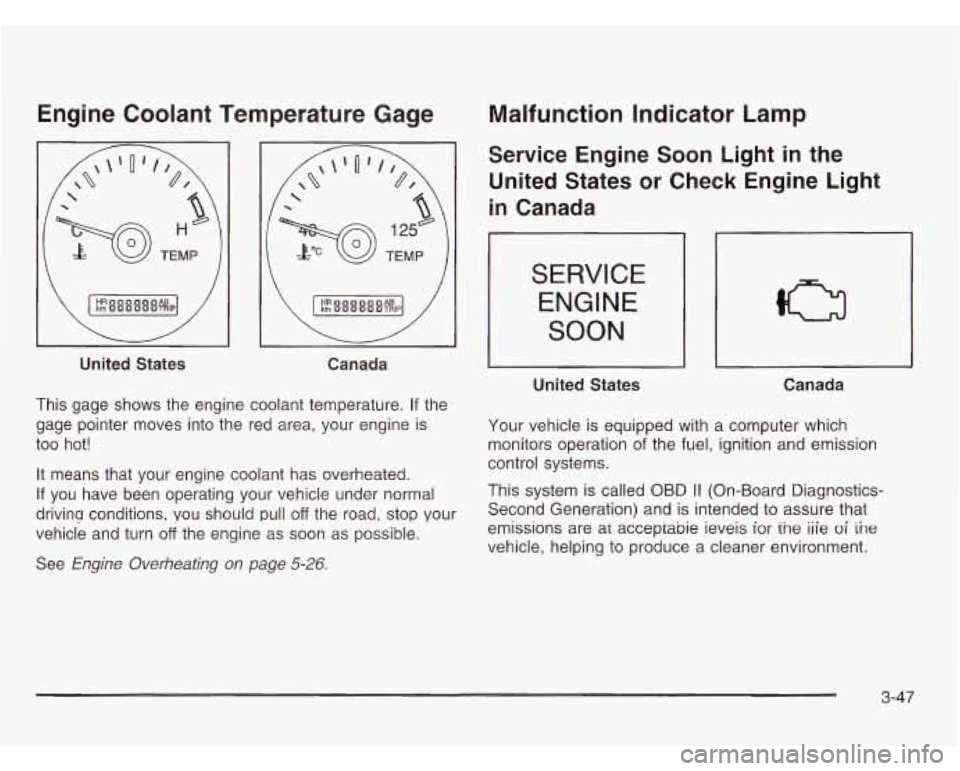
Engine Coolant Temperature Gage
United States
\[-I/
u
Canada
This gage shows the engine coolant temperature.
If the
gage pointer moves into the red area, your engine is
too hot!
It means that your engine coolant has overheated.
If you have been operating your vehicle under normal
drivinq conditions, vou should pull
off the road, stop your
vehicle and turn
off the engine as soon as possible.
See
Engine Overheating on page 5-26.
Malfunction Indicator Lamp
Service Engine Soon Light in the
United States or Check Engine Light
in Canada
SERVICE
ENGINE
SOON
United States Canada
Your vehicle is equipped with a computer which
monitors operation
of the fuel, ignition and emission
control systems.
This system is called
OBD II (On-Board Diagnostics-
Second Generation) and is intended
to assure that
emissions are at accepiabie ieveis ior ine iiie
of ihe
vehicle, helping to produce a cleaner environment.
3-47
Page 205 of 466
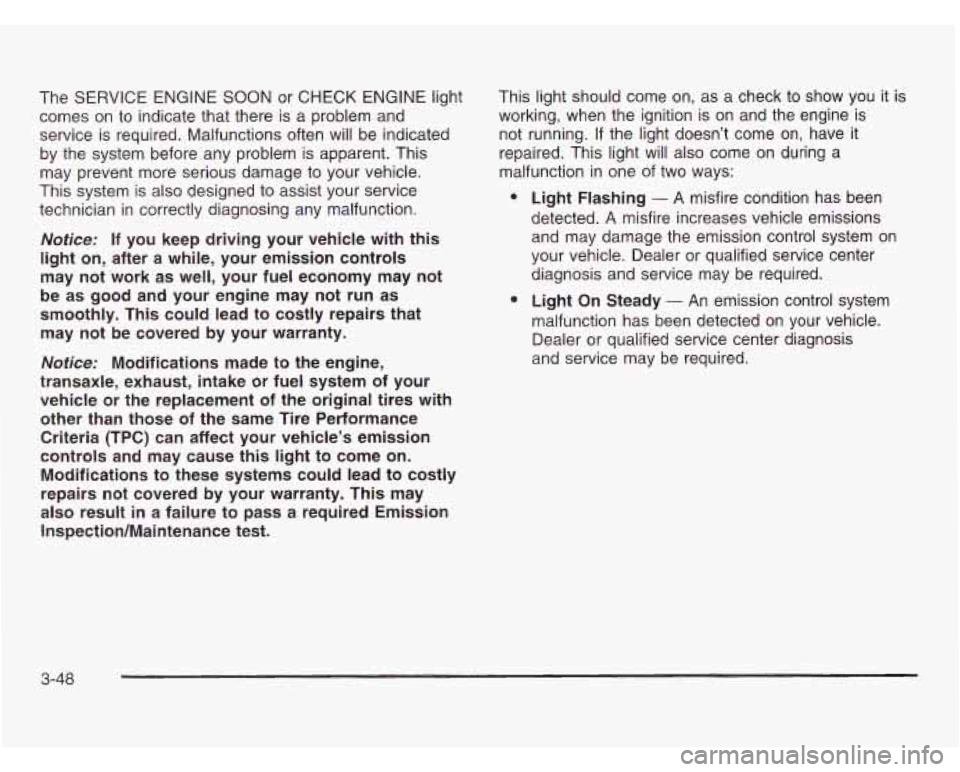
The SERVICE ENGINE SOON or CHECK ENGINE light
comes on to indicate that there is a problem and
service is required. Malfunctions often
will be indicated
by the system before any problem is apparent. This
may prevent more serious damage to your vehicle.
This system is also designed to assist your service
technician in correctly diagnosing any malfunction.
Notice: If you keep driving your vehicle with this
light on, after a while, your emission controls
may not work as well, your fuel economy may not
be as good and your engine may not run as
smoothly. This could lead to costly repairs that may not be covered by your warranty.
Notice: Modifications made to the engine,
transaxle, exhaust, intake or fuel system of your vehicle or the replacement
of the original tires with
other than those of the same Tire Performance
Criteria (TPC) can affect your vehicle’s emission
controls and may cause this light to come
on.
Modifications to these systems could lead to costly
repairs not covered by your warranty. This may
also result in a failure to pass a required Emission Inspection/Maintenance test. This light should
come on, as a check to show you it is
working, when the ignition is on and the engine is
not running.
If the light doesn’t come on, have it
repaired. This light will also come on during a
malfunction in one of two ways:
Light Flashing
- A misfire condition has been
detected. A misfire increases vehicle emissions
and may damage the emission control system on
your vehicle. Dealer or qualified service center
diagnosis and service may be required.
Light On Steady
- An emission control system
malfunction has been detected on your vehicle.
Dealer or qualified service center diagnosis
and service may be required.
3-48
Page 207 of 466

Have you recently changed brands of fuel?
If so, be sure to fuel your vehicle with quality fuel.
See
Gasoline Octane on page 5-5. Poor fuel quality
will cause your engine not to run as efficiently as
designed. You may notice this as stalling after start-up,
stalling when you put the vehicle into gear, misfiring,
hesitation on acceleration or stumbling on acceleration.
(These conditions may go away once the engine is
warmed up.) This will be detected by the system and
cause the light to turn on.
If you experience one or more of these conditions,
change the fuel brand you use. It will require at least
one full tank of the proper fuel to turn the light
off.
If none of the above steps have made the light turn off,
have your dealer or qualified service center check
the vehicle. Your dealer has the proper test equipment
and diagnostic tools to fix any mechanical or electrical
problems that may have developed.
Emissions Inspection and
Maintenance Programs
Some state/provincial and local governments have or
may begin programs to inspect the emission control
equipment on your vehicle. Failure to pass this
inspection could prevent you from getting a vehicle
registration.
Here are some things you need
to know to help your
vehicle pass an inspection:
Your vehicle will not pass this inspection
if the SERVICE
ENGINE SOON or
CHECK ENGINE light is on or not
working properly.
Your vehicle will not pass this inspection
if the OBD
(on-board diagnostic) system determines that critical
emission control systems have not been completely
diagnosed by the system. The vehicle would be
considered not ready for inspection. This can happen
if you have recently replaced your battery or if your
battery has run down. The diagnostic system is
designed to evaluate critical emission control systems
during normal driving. This may take several days
of routine driving.
If you have done this and your vehicle
still does not pass the inspection for lack of
OBD
system readiness, see your dealer or qualified service
center to prepare the vehicle for inspection.
3-50
Page 270 of 466

Avoid needless heavy braking. Some people drive
in spurts
- heavy acceleration followed by heavy
braking
- rather than keeping pace with traffic. This is
a mistake. Your brakes may not have time to cool
between hard stops. Your brakes will wear out much
faster
if you do a lot of heavy braking. If you keep pace
with the traffic and allow realistic following distances,
you will eliminate a lot of unnecessary braking.
That means better braking and longer brake life.
If your engine ever stops while you’re driving, brake
normally but don’t pump your brakes.
If you do,
the pedal may get harder to push down.
If your engine
stops, you will still have some power brake assist.
But you will use
it when you brake. Once the power
assist is used up, it may take longer to stop and
the brake pedal will be harder to push.
Anti-lock Brake System (ABS)
Your vehicle may have anti-lock brakes. ABS is an
advanced electronic braking system that will help prevent a braking skid.
If your vehicle has anti-lock
brakes, this warning light
on the instrument panel will
come on briefly when
you start your vehicle.
When you start your engine, or when you begin to
drive away, your anti-lock brake system will check
itself. You may hear a momentary motor or clicking
noise while this test is going on, and you may even
notice that your brake pedal moves or pulses a little.
This is normal.
4-7
Page 316 of 466
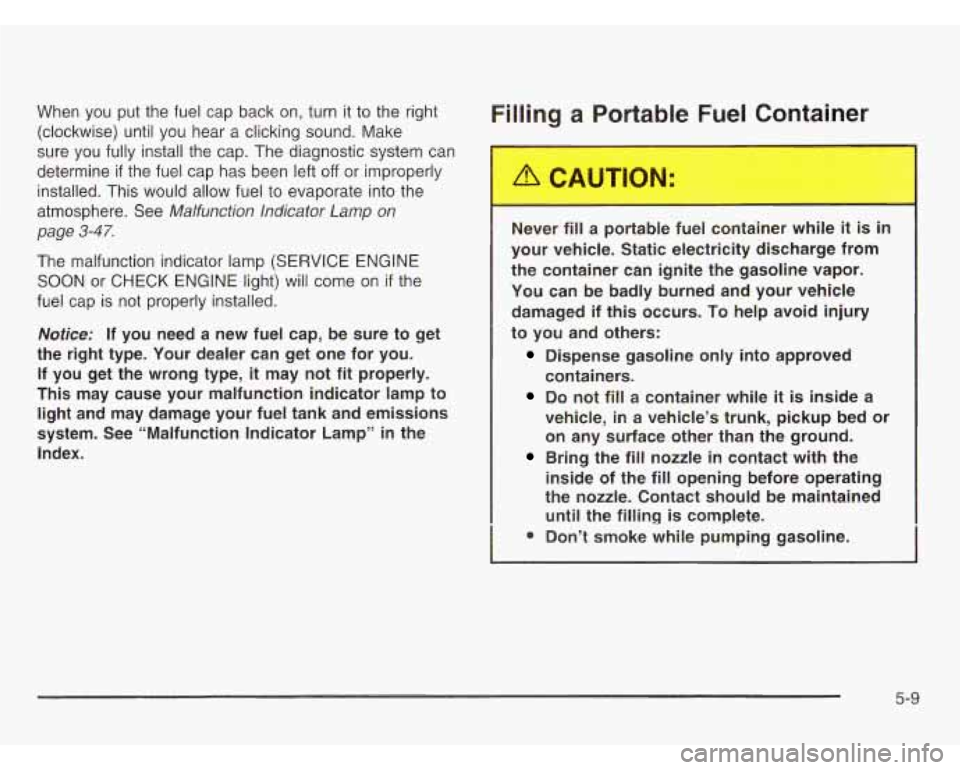
When you put the fuel cap back on, turn it to the right
(clockwise) until you hear a clicking sound. Make
sure you fully install the cap. The diagnostic system can
determine
if the fuel cap has been left off or improperly
installed. This would allow fuel to evaporate into the
atmosphere. See
Malfunction Indicator Lamp on
page 3-47.
The malfunction indicator lamp (SERVICE ENGINE
SOON or CHECK ENGINE light) will come on
if the
fuel cap is not properly installed.
Notice: If you need a new fuel cap, be sure to get
the right type. Your dealer can get one for you.
If you get the wrong type, it may not fit properly.
This may cause your malfunction indicator lamp to
light and may damage your fuel tank and emissions
system. See “Malfunction Indicator Lamp”
in the
Index.
Filling a Po -able Fuel C ‘ainer
I-
I fil portablc uel container while it is in
your vehicle. Static electricity discharge from
the container can ignite the gasoline vapor.
You can be badly burned and your vehicle
damaged if this occurs.
To help avoid injury
to you and others:
Dispense gasoline only into approved
containers.
Do not fill a container while it is inside a
vehicle, in a vehicle’s trunk, pickup bed or on any surface other than the ground.
Bring the fill nozzle in contact with the
inside of the fill opening before operating
the nozzle. Contact should be maintained
until the filling is complete.
0 Don’t smoke while pumping gasoline.
5-9
Page 347 of 466
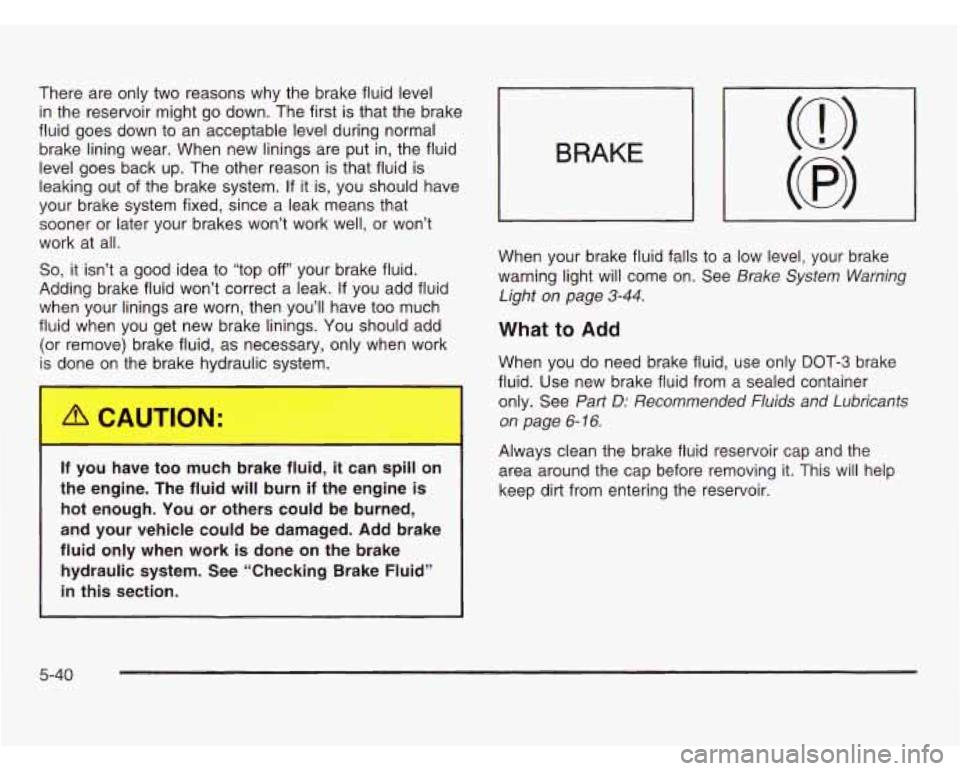
There are only two reasons why the brake fluid level
in the reservoir might go down. The first is that the brake
fluid goes down to an acceptable level during normal
brake lining wear. When new linings are put
in, the fluid
level goes back up. The other reason is that fluid
is
leaking out of the brake system. If it is, you should have
your brake system fixed, since a leak means that
sooner or later your brakes won’t work well, or won’t
work at all.
So, it isn’t a good idea to “top off your brake fluid.
Adding brake fluid won’t correct a leak.
If you add fluid
when your linings are worn, then you’ll have too much
fluid when you get new brake linings.
You should add
(or remove) brake fluid, as necessary, only when work
is done on the brake hydraulic system.
1. ,’- have too much brake fLJ, it can spi.. an
the engine. The fluid will burn
if the engine is
hot enough. You or others could be burned,
and your vehicle could be damaged. Add brake
fluid only when work is done on the brake
hydraulic system. See “Checking Brake Fluid”
in this section.
BRAKE
When your brake fluid falls to a low level, your brake
warning light will come on. See
Brake System Warning
Light on page
3-44.
What to Add
When you do need brake fluid, use only DOT-3 brake
fluid. Use new brake fluid from a sealed container
only. See
Part D: Recommended Fluids and Lubricants
on page 6- 16.
Always clean the brake fluid reservoir cap and the
area around the cap before removing it. This
will help
keep dirt from entering the reservoir.
5-40
Page 353 of 466
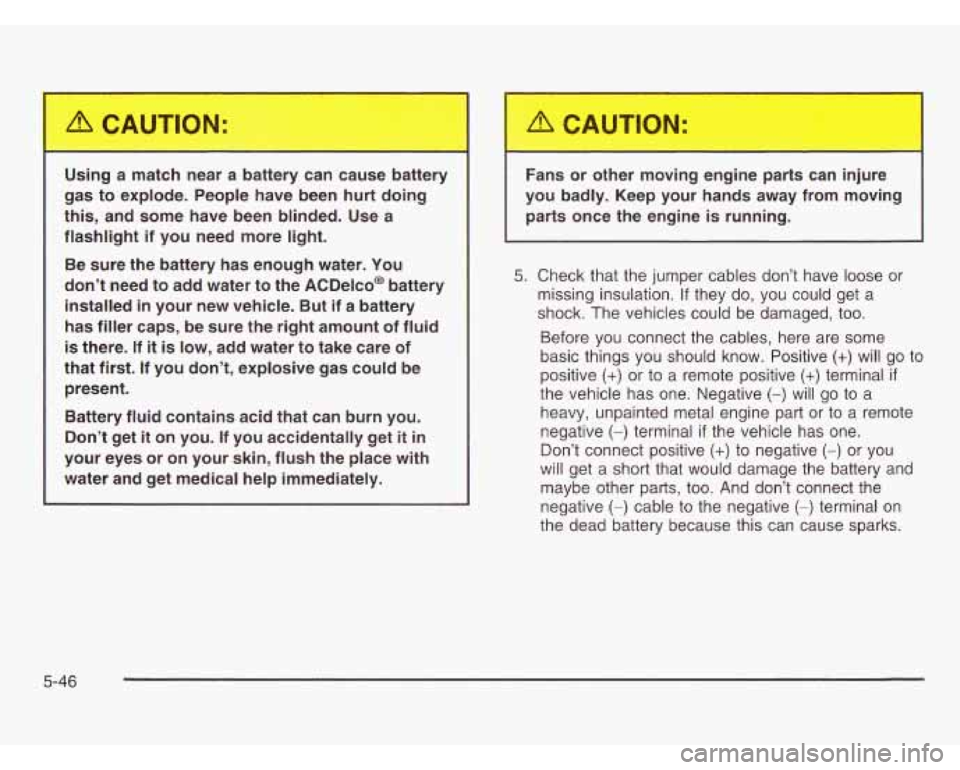
--
1
Using a match near a battery can cause battery
gas to explode. People have been hurt doing
this, and some have been blinded. Use a
flashlight if you need more light.
Be sure the battery has enough water. You
don’t need to add water to the ACDelco@ battery
installed
in your new vehicle. But if a battery
has filler caps, be sure the right amount
of fluid
is there. If it is low, add water to take care of
that first. If you don’t, explosive gas could be
present.
Battery fluid contains acid that can burn you.
Don’t get
it on you. If you accidentally get it in
your eyes or on your skin,
flush the place with
water and get medical help immediately. Fans or other moving engine parts can injure
you badly. Keep your hands away from moving
parts once the engine is running.
5. Check that the jumper cables don’t have loose or
missing insulation.
If they do, you could get a
shock. The vehicles could be damaged, too.
Before you connect the cables, here are some
basic things you should know. Positive
(+) will go to
positive
(+) or to a remote positive (+) terminal if
the vehicle has one. Negative (-) will go to a
heavy, unpainted metal engine part or to a remote
negative
(-) terminal if the vehicle has one.
Don’t connect positive
(+) to negative (-) or you
will get a short that would damage the battery and
maybe other parts, too. And don’t connect the
negative
(-) cable to the negative (-) terminal on
the dead battery because this can cause sparks.
5-46
Page 423 of 466
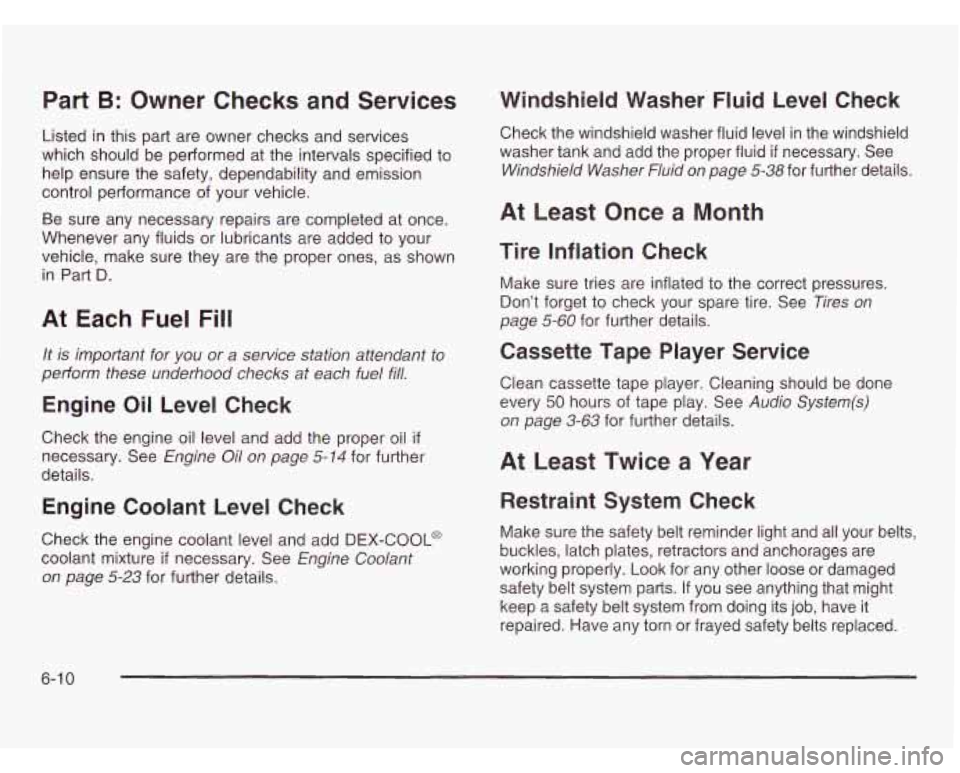
Part B: Owner Checks and Services
Listed in this part are owner checks and services
which should be performed at the intervals specified to
help ensure the safety, dependability and emission
control performance of your vehicle.
Be sure any necessary repairs are completed at once.
Whenever any fluids or lubricants are added to your
vehicle, make sure they are the proper ones, as shown
in Part D.
At Each Fuel Fill
It is important for you or a service station attendant to
perform these underhood checks at each fuel fill.
Engine Oil Level Check
Check the engine oil level and add the proper oil if
necessary. See Engine Oil on page 5-14 for further
details.
Engine Coolant Level Check
Check the engine coolant level and add DEX-COOL@
coolant mixture
if necessary. See Engine Coolant
on page 5-23
for further details.
Windshield Washer Fluid Level Check
Check the windshield washer fluid level in the windshield
washer tank and add the proper fluid
if necessary. See
Windshield Washer Fluid on page 5-38 for further details.
At Least Once a Month
Tire Inflation Check
Make sure tries are inflated to the correct pressures.
Don’t forget to check your spare tire. See
Tires on
page 5-60
for further details.
Cassette Tape Player Service
Clean cassette tape player. Cleaning should be done
every
50 hours of tape play. See Audio Systern(s)
on page 3-63 for further details.
At Least Twice a Year
Restraint System Check
:s , Make sure the safety belt reminder light and all your bell
buckles, latch plates, retractors and anchorages are
working properly. Look for any other loose or damaged
safety belt system parts.
If you see anything that might
keep a safety belt system from doing its
job, have it
repaired. Have any torn or frayed safety belts replaced.
6-1 0
Page 448 of 466

Capacities and Specifications .......................... 5-1 03
Captain Chairs. Rear
....................................... 1-13
Carbon Monoxide
................... 4-26, 4-36, 2-22, 2-43
Care of
Safety Belts
................................................ 5-90
Care of Your
Cassette Tape Player
................................. 3-103
CD and DVD Player
................................... 3-104
CDs and DVDs ......................................... 3-104
Cargo Lamp
................................................... 3-20
Carrier Assembly-Differential
(Rear Drive Module)
.................................... 5-51
Cassette Tape Messages
................................. 3-77
Cassette Tape Player Service
........................... 6-10
CD Adapter Kits
............................................. 3-78
Chains, Tires
.................................................. 5-67
Change Engine Oil Message
............................ 3-56
Charging System Indicator Message
.................. 3-54
Check
Checking Coolant
............................................ 5-24
Checking or Replacing the Engine Air CleanedFilter
......................................... 5-1 9
Checking Things Under the Hood
...................... 5-10
Center Passenger Position, Safety Belts ............. 1-37
Engine Light
............................................... 3-47
PhneLinm Enm;nn A:I VI l~ur\iIly Li lyll IG VI1 4- I y. 4A ........................................
Checking Your Restraint Systems ...................... 1-77
Chemical Paint Spotting
................................... 5-93 Child Restraints
Child Restraint Systems
............................... 1-51
Infants and Young Children
........................... 1-48
Lower Anchorages and Top Tethers for
Children (LATCH System)
.......................... 1-58
Older Children
.......................................... 1-45
Securing a Child Restraint Designed for
the LATCH System
................................ 1-60
Securing a Child Restraint in a Center
Seat Position
........................................... 1-64
Securing a Child Restraint in a Rear
Outside Seat Position
............................... 1-60
Securing a Child Restraint in the Right
Front Seat Position
................................... 1-66
Top Strap
................................................... 1-55
Where to Put the Restraint
........................... 1-54
Inside of Your Vehicle
.................................. 5-87
Outside of Your Vehicle
................................ 5-90
Underbody Maintenance
............................... 5-93
Video Screen
............................................ 3-105
VVedll IelsLI Ips 5-YU
Your DVD Player ....................................... 3-105
Cleaning Exterior LampsILenses
....................... 5-91
Air Filter, Passenger Compartment
................. 3-37
Dual
.......................................................... 3-28
-I--- iup S+m clap Anchor L~atio~~ 1-56 ............................
Cleaning
I A r- -11- - .._I .. I .. 1- ..............................................
Climate Control System ................................... 3-25
3